- GCN/BACODINE POSITION NOTICE
TITLE: GCN/SWIFT NOTICE
NOTICE_DATE: Wed 27 Sep 06 14:07:47 UT
NOTICE_TYPE: Swift-BAT GRB Position
TRIGGER_NUM: 231362, Seg_Num: 0
GRB_RA: 329.553d {+21h 58m 13s} (J2000),
329.637d {+21h 58m 33s} (current),
328.925d {+21h 55m 42s} (1950)
GRB_DEC: +5.353d {+05d 21' 10"} (J2000),
+5.385d {+05d 23' 06"} (current),
+5.113d {+05d 06' 48"} (1950)
GRB_ERROR: 3.00 [arcmin radius, statistical only]
GRB_INTEN: 2030 [cnts] Image_Peak=220 [image_cnts]
TRIGGER_DUR: 0.256 [sec]
TRIGGER_INDEX: 123 E_range: 25-100 keV
BKG_INTEN: 31158 [cnts]
BKG_TIME: 50838.52 SOD {14:07:18.52} UT
BKG_DUR: 8 [sec]
GRB_DATE: 14005 TJD; 270 DOY; 06/09/27
GRB_TIME: 50855.29 SOD {14:07:35.29} UT
GRB_PHI: -97.70 [deg]
GRB_THETA: 16.59 [deg]
SOLN_STATUS: 0x3
RATE_SIGNIF: 32.14 [sigma]
IMAGE_SIGNIF: 12.06 [sigma]
MERIT_PARAMS: +1 +0 +0 +0 +2 +17 +0 +0 +82 +1
SUN_POSTN: 183.97d {+12h 15m 54s} -1.72d {-01d 43' 13"}
SUN_DIST: 145.54 [deg] Sun_angle= -9.7 [hr] (East of Sun)
MOON_POSTN: 237.29d {+15h 49m 10s} -25.00d {-25d 00' 04"}
MOON_DIST: 94.39 [deg]
MOON_ILLUM: 22 [%]
GAL_COORDS: 64.12,-37.03 [deg] galactic lon,lat of the burst (or transient)
ECL_COORDS: 333.62, 16.64 [deg] ecliptic lon,lat of the burst (or transient)
COMMENTS: SWIFT-BAT GRB Coordinates.
COMMENTS: This is a rate trigger.
COMMENTS: A point_source was found.
COMMENTS: This does not match any source in the on-board catalog.
COMMENTS: This does not match any source in the ground catalog.
COMMENTS: This is a GRB.
COMMENTS: This trigger occurred at longitude,latitude = 169.44,-8.50 [deg].
- red DSS finding chart
ps-file
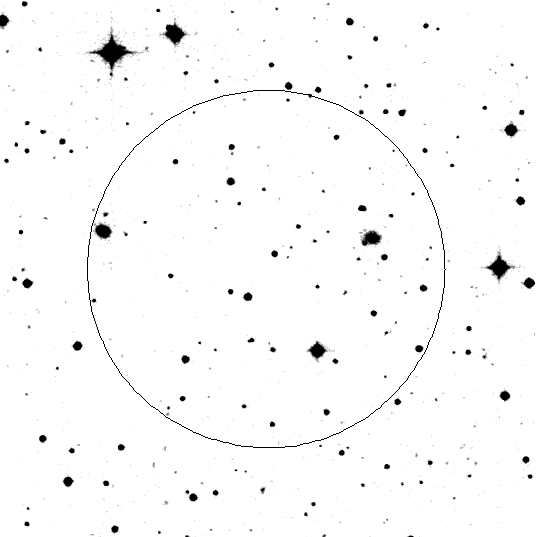
- GCN NOTICE
TITLE: GCN/SWIFT NOTICE
NOTICE_DATE: Wed 27 Sep 06 14:08:50 UT
NOTICE_TYPE: Swift-XRT Nack-Position
TRIGGER_NUM: 231362, Seg_Num: 0
POINT_RA: 329.563d {+21h 58m 15s} (J2000)
POINT_DEC: +5.343d {+05d 20' 36"} (J2000)
IMG_START_DATE: 14005 TJD; 270 DOY; 06/09/27
IMG_START_TIME: 50920.01 SOD {14:08:40.01} UT, 64.7 [sec] since BAT Trigger Time
COUNTS: 11 Min_needed= 20
STD_DEV: 0.00 Max_StdDev_for_Good=28.44 [arcsec]
PH2_ITER: 2 Max_iter_allowed= 4
ERROR_CODE: 1
COMMENTS: SWIFT-XRT Nack Position.
COMMENTS: No source found in the image.
- GCN NOTICE
TITLE: GCN/SWIFT NOTICE
NOTICE_DATE: Wed 27 Sep 06 14:10:49 UT
NOTICE_TYPE: Swift-UVOT Source List
TRIGGER_NUM: 231362, Seg_Num: 0
POINT_RA: 329.564d {+21h 58m 15s} (J2000)
POINT_DEC: +5.343d {+05d 20' 36"} (J2000)
POINT_ROLL: 274.768d
IMG_START_DATE: 14005 TJD; 270 DOY; 06/09/27
IMG_START_TIME: 50924.86 SOD {14:08:44.86} UT, 69.6 [sec] since BAT Trigger Time
FILTER: 10, White
BKG_MEAN: 1.549
N_STARS: 64
X_OFFSET: 593 [pixels]
Y_OFFSET: 559 [pixels]
X_MAX: 1552 [pixels]
Y_MAX: 1518 [pixels]
DET_THRESH: 10
PHOTO_THRESH: 5
SL_URL: sw00231362000msufc0069.fits
SUN_POSTN: 183.98d {+12h 15m 54s} -1.72d {-01d 43' 16"}
SUN_DIST: 145.55 [deg] Sun_angle= -9.7 [hr] (East of Sun)
MOON_POSTN: 237.32d {+15h 49m 17s} -25.01d {-25d 00' 28"}
MOON_DIST: 94.37 [deg]
MOON_ILLUM: 22 [%]
GAL_COORDS: 64.12,-37.05 [deg] galactic lon,lat of the pointing direction
ECL_COORDS: 333.62, 16.62 [deg] ecliptic lon,lat of the pointing direction
COMMENTS: SWIFT-UVOT Source List.
- GCN NOTICE
TITLE: GCN/SWIFT NOTICE
NOTICE_DATE: Wed 27 Sep 06 14:11:18 UT
NOTICE_TYPE: Swift-UVOT Processed Source List
TRIGGER_NUM: 231362, Seg_Num: 0
POINT_RA: 329.564d {+21h 58m 15s} (J2000)
POINT_DEC: +5.343d {+05d 20' 36"} (J2000)
POINT_ROLL: 274.768d
IMG_START_DATE: 14005 TJD; 270 DOY; 06/09/27
IMG_START_TIME: 50924.86 SOD {14:08:44.86} UT, 69.6 [sec] since BAT Trigger Time
FILTER: 10, White
BKG_MEAN: 1.549
N_STARS: 64
X_OFFSET: 593 [pixels]
Y_OFFSET: 559 [pixels]
X_MAX: 1552 [pixels]
Y_MAX: 1518 [pixels]
DET_THRESH: 10
PHOTO_THRESH: 5
SL_URL: sw00231362000msufc0069.fits
SUN_POSTN: 183.98d {+12h 15m 54s} -1.72d {-01d 43' 16"}
SUN_DIST: 145.55 [deg] Sun_angle= -9.7 [hr] (East of Sun)
MOON_POSTN: 237.33d {+15h 49m 18s} -25.01d {-25d 00' 32"}
MOON_DIST: 94.37 [deg]
MOON_ILLUM: 22 [%]
GAL_COORDS: 64.12,-37.05 [deg] galactic lon,lat of the pointing direction
ECL_COORDS: 333.62, 16.62 [deg] ecliptic lon,lat of the pointing direction
COMMENTS: SWIFT-UVOT Processed Source List.
COMMENTS: All 4 attachments are included.
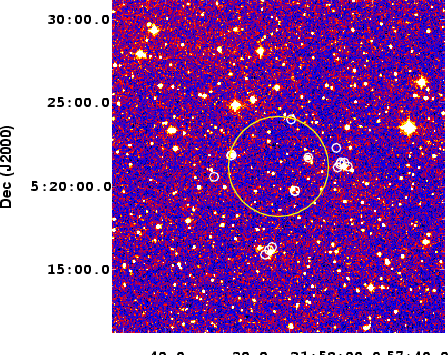
- GCN NOTICE
TITLE: GCN/SWIFT NOTICE
NOTICE_DATE: Wed 27 Sep 06 14:12:50 UT
NOTICE_TYPE: Swift-UVOT Image
TRIGGER_NUM: 231362, Seg_Num: 0
POINT_RA: 329.564d {+21h 58m 15s} (J2000)
POINT_DEC: +5.343d {+05d 20' 36"} (J2000)
ROLL: 274.768d
IMG_START_DATE: 14005 TJD; 270 DOY; 06/09/27
IMG_START_TIME: 50924.86 SOD {14:08:44.86} UT, 69.6 [sec] since BAT Trigger Time
FILTER: 10, White
EXPOSURE_ID: 181058926
X_OFFSET: 912 [pixels]
Y_OFFSET: 878 [pixels]
WIDTH: 160 [pixels]
HEIGHT: 160 [pixels]
X_GRB_POS: 1072
Y_GRB_POS: 1038
BINNING_INDEX: 1
IM_URL: sw00231362000msuni0069.fits
SUN_POSTN: 183.98d {+12h 15m 54s} -1.72d {-01d 43' 18"}
SUN_DIST: 145.55 [deg] Sun_angle= -9.7 [hr] (East of Sun)
MOON_POSTN: 237.34d {+15h 49m 22s} -25.01d {-25d 00' 44"}
MOON_DIST: 94.36 [deg]
MOON_ILLUM: 22 [%]
GAL_COORDS: 64.12,-37.05 [deg] galactic lon,lat of the pointing direction
ECL_COORDS: 333.62, 16.62 [deg] ecliptic lon,lat of the pointing direction
COMMENTS: SWIFT-UVOT Image.
COMMENTS: The GRB Position came from the Window Position in the Mode Command.
COMMENTS: The image has 2x2 binning (compression).
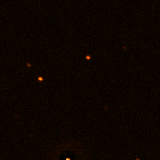
- GCN NOTICE
TITLE: GCN/SWIFT NOTICE
NOTICE_DATE: Wed 27 Sep 06 14:13:09 UT
NOTICE_TYPE: Swift-UVOT Processed Image
TRIGGER_NUM: 231362, Seg_Num: 0
POINT_RA: 329.564d {+21h 58m 15s} (J2000)
POINT_DEC: +5.343d {+05d 20' 36"} (J2000)
ROLL: 274.768d
IMG_START_DATE: 14005 TJD; 270 DOY; 06/09/27
IMG_START_TIME: 50924.86 SOD {14:08:44.86} UT, 69.6 [sec] since BAT Trigger Time
FILTER: 10, White
EXPOSURE_ID: 181058926
X_OFFSET: 912 [pixels]
Y_OFFSET: 878 [pixels]
WIDTH: 160 [pixels]
HEIGHT: 160 [pixels]
X_GRB_POS: 1072
Y_GRB_POS: 1038
BINNING_INDEX: 1
IM_URL: sw00231362000msuni0069.fits
SUN_POSTN: 183.98d {+12h 15m 54s} -1.72d {-01d 43' 18"}
SUN_DIST: 145.55 [deg] Sun_angle= -9.7 [hr] (East of Sun)
MOON_POSTN: 237.34d {+15h 49m 22s} -25.01d {-25d 00' 46"}
MOON_DIST: 94.35 [deg]
MOON_ILLUM: 22 [%]
GAL_COORDS: 64.12,-37.05 [deg] galactic lon,lat of the pointing direction
ECL_COORDS: 333.62, 16.62 [deg] ecliptic lon,lat of the pointing direction
COMMENTS: SWIFT-UVOT Processed Image.
COMMENTS: The GRB Position came from the Window Position in the Mode Command.
COMMENTS: The image has 2x2 binning (compression).
COMMENTS: All 4 attachments are included.
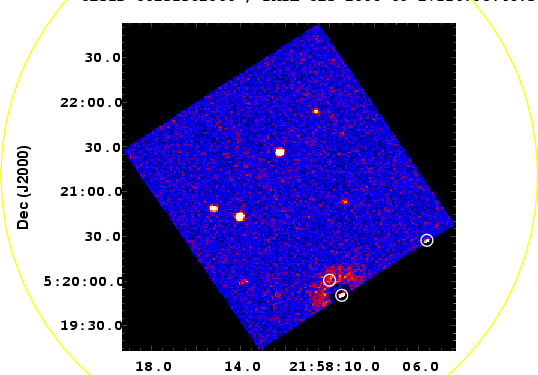
- GCN NOTICE
TITLE: GCN/SWIFT NOTICE
NOTICE_DATE: Wed 27 Sep 06 14:17:39 UT
NOTICE_TYPE: Swift-XRT Position
TRIGGER_NUM: 231362, Seg_Num: 0
GRB_RA: 329.5511d {+21h 58m 12.2s} (J2000),
329.6356d {+21h 58m 32.5s} (current),
328.9237d {+21h 55m 41.6s} (1950)
GRB_DEC: +5.3647d {+05d 21' 52.9"} (J2000),
+5.3971d {+05d 23' 49.3"} (current),
+5.1255d {+05d 07' 31.6"} (1950)
GRB_ERROR: 5.8 [arcsec radius, statistical plus systematic, 90% containment]
GRB_INTEN: 1.00e-10 [erg/cm2/sec]
GRB_SIGNIF: 5.00 [sigma]
IMG_START_DATE: 14005 TJD; 270 DOY; 06/09/27
IMG_START_TIME: 50920.01 SOD {14:08:40.01} UT, 64.7 [sec] since BAT Trigger Time
TAM[0-3]: 327.61 237.19 261.35 242.66
AMPLIFIER: 2
WAVEFORM: 134
SUN_POSTN: 183.98d {+12h 15m 55s} -1.72d {-01d 43' 22"}
SUN_DIST: 145.53 [deg] Sun_angle= -9.7 [hr] (East of Sun)
MOON_POSTN: 237.38d {+15h 49m 32s} -25.02d {-25d 01' 21"}
MOON_DIST: 94.31 [deg]
MOON_ILLUM: 22 [%]
GAL_COORDS: 64.13,-37.02 [deg] galactic lon,lat of the burst
ECL_COORDS: 333.62, 16.65 [deg] ecliptic lon,lat of the burst
COMMENTS: SWIFT-XRT Coordinates.
COMMENTS: This Notice was ground-generated -- not flight-generated.
COMMENTS: TAM values are not valid.
- GCN NOTICE
TITLE: GCN/SWIFT NOTICE
NOTICE_DATE: Wed 27 Sep 06 14:18:26 UT
NOTICE_TYPE: Swift-UVOT Source List
TRIGGER_NUM: 231362, Seg_Num: 0
POINT_RA: 329.566d {+21h 58m 16s} (J2000)
POINT_DEC: +5.343d {+05d 20' 36"} (J2000)
POINT_ROLL: 274.770d
IMG_START_DATE: 14005 TJD; 270 DOY; 06/09/27
IMG_START_TIME: 51030.13 SOD {14:10:30.13} UT, 174.8 [sec] since BAT Trigger Time
FILTER: 3, V
BKG_MEAN: 0.876
N_STARS: 67
X_OFFSET: 593 [pixels]
Y_OFFSET: 559 [pixels]
X_MAX: 1552 [pixels]
Y_MAX: 1518 [pixels]
DET_THRESH: 8
PHOTO_THRESH: 4
SL_URL: sw00231362000msufc0174.fits
SUN_POSTN: 183.98d {+12h 15m 55s} -1.72d {-01d 43' 23"}
SUN_DIST: 145.55 [deg] Sun_angle= -9.7 [hr] (East of Sun)
MOON_POSTN: 237.39d {+15h 49m 34s} -25.02d {-25d 01' 27"}
MOON_DIST: 94.31 [deg]
MOON_ILLUM: 22 [%]
GAL_COORDS: 64.12,-37.05 [deg] galactic lon,lat of the pointing direction
ECL_COORDS: 333.62, 16.62 [deg] ecliptic lon,lat of the pointing direction
COMMENTS: SWIFT-UVOT Source List.
- GCN NOTICE
TITLE: GCN/SWIFT NOTICE
NOTICE_DATE: Wed 27 Sep 06 14:18:49 UT
NOTICE_TYPE: Swift-UVOT Processed Source List
TRIGGER_NUM: 231362, Seg_Num: 0
POINT_RA: 329.566d {+21h 58m 16s} (J2000)
POINT_DEC: +5.343d {+05d 20' 36"} (J2000)
POINT_ROLL: 274.770d
IMG_START_DATE: 14005 TJD; 270 DOY; 06/09/27
IMG_START_TIME: 51030.13 SOD {14:10:30.13} UT, 174.8 [sec] since BAT Trigger Time
FILTER: 3, V
BKG_MEAN: 0.876
N_STARS: 67
X_OFFSET: 593 [pixels]
Y_OFFSET: 559 [pixels]
X_MAX: 1552 [pixels]
Y_MAX: 1518 [pixels]
DET_THRESH: 8
PHOTO_THRESH: 4
SL_URL: sw00231362000msufc0174.fits
SUN_POSTN: 183.98d {+12h 15m 55s} -1.72d {-01d 43' 23"}
SUN_DIST: 145.55 [deg] Sun_angle= -9.7 [hr] (East of Sun)
MOON_POSTN: 237.39d {+15h 49m 35s} -25.03d {-25d 01' 30"}
MOON_DIST: 94.31 [deg]
MOON_ILLUM: 22 [%]
GAL_COORDS: 64.12,-37.05 [deg] galactic lon,lat of the pointing direction
ECL_COORDS: 333.62, 16.62 [deg] ecliptic lon,lat of the pointing direction
COMMENTS: SWIFT-UVOT Processed Source List.
COMMENTS: All 4 attachments are included.
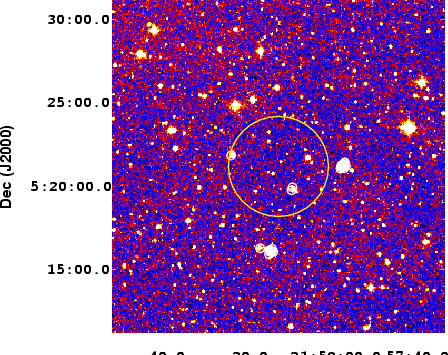
- GCN NOTICE
TITLE: GCN/SWIFT NOTICE
NOTICE_DATE: Wed 27 Sep 06 14:19:32 UT
NOTICE_TYPE: Swift-UVOT Image
TRIGGER_NUM: 231362, Seg_Num: 0
POINT_RA: 329.566d {+21h 58m 16s} (J2000)
POINT_DEC: +5.343d {+05d 20' 36"} (J2000)
ROLL: 274.770d
IMG_START_DATE: 14005 TJD; 270 DOY; 06/09/27
IMG_START_TIME: 51030.13 SOD {14:10:30.13} UT, 174.8 [sec] since BAT Trigger Time
FILTER: 3, V
EXPOSURE_ID: 181059031
X_OFFSET: 912 [pixels]
Y_OFFSET: 878 [pixels]
WIDTH: 160 [pixels]
HEIGHT: 160 [pixels]
X_GRB_POS: 1072
Y_GRB_POS: 1038
BINNING_INDEX: 1
IM_URL: sw00231362000msuni0174.fits
SUN_POSTN: 183.98d {+12h 15m 55s} -1.72d {-01d 43' 24"}
SUN_DIST: 145.55 [deg] Sun_angle= -9.7 [hr] (East of Sun)
MOON_POSTN: 237.40d {+15h 49m 36s} -25.03d {-25d 01' 36"}
MOON_DIST: 94.30 [deg]
MOON_ILLUM: 22 [%]
GAL_COORDS: 64.12,-37.05 [deg] galactic lon,lat of the pointing direction
ECL_COORDS: 333.62, 16.62 [deg] ecliptic lon,lat of the pointing direction
COMMENTS: SWIFT-UVOT Image.
COMMENTS: The GRB Position came from the Window Position in the Mode Command.
COMMENTS: The image has 2x2 binning (compression).
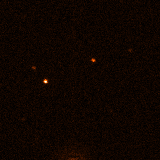
- GCN NOTICE
TITLE: GCN/SWIFT NOTICE
NOTICE_DATE: Wed 27 Sep 06 14:19:52 UT
NOTICE_TYPE: Swift-UVOT Processed Image
TRIGGER_NUM: 231362, Seg_Num: 0
POINT_RA: 329.566d {+21h 58m 16s} (J2000)
POINT_DEC: +5.343d {+05d 20' 36"} (J2000)
ROLL: 274.770d
IMG_START_DATE: 14005 TJD; 270 DOY; 06/09/27
IMG_START_TIME: 51030.13 SOD {14:10:30.13} UT, 174.8 [sec] since BAT Trigger Time
FILTER: 3, V
EXPOSURE_ID: 181059031
X_OFFSET: 912 [pixels]
Y_OFFSET: 878 [pixels]
WIDTH: 160 [pixels]
HEIGHT: 160 [pixels]
X_GRB_POS: 1072
Y_GRB_POS: 1038
BINNING_INDEX: 1
IM_URL: sw00231362000msuni0174.fits
SUN_POSTN: 183.98d {+12h 15m 55s} -1.72d {-01d 43' 25"}
SUN_DIST: 145.55 [deg] Sun_angle= -9.7 [hr] (East of Sun)
MOON_POSTN: 237.40d {+15h 49m 37s} -25.03d {-25d 01' 39"}
MOON_DIST: 94.30 [deg]
MOON_ILLUM: 22 [%]
GAL_COORDS: 64.12,-37.05 [deg] galactic lon,lat of the pointing direction
ECL_COORDS: 333.62, 16.62 [deg] ecliptic lon,lat of the pointing direction
COMMENTS: SWIFT-UVOT Processed Image.
COMMENTS: The GRB Position came from the Window Position in the Mode Command.
COMMENTS: The image has 2x2 binning (compression).
COMMENTS: All 4 attachments are included.
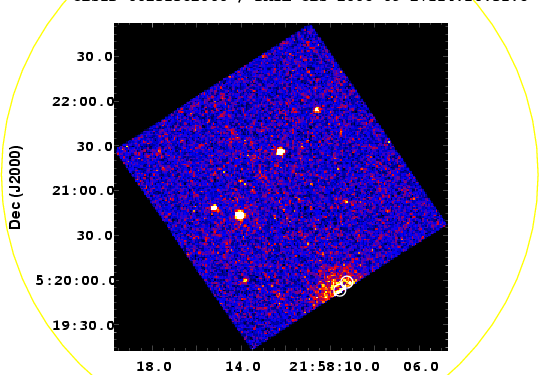
- GCN Circular #5627
L. M. Barbier (NASA/GSFC), S. D. Barthelmy (GSFC),
A. P. Beardmore (U Leicester), P. J. Brown (PSU),
D. N. Burrows (PSU), S. Campana (INAF-OAB), M.L. Conciatore (ASDC),
P. A. Evans (U Leicester), N. Gehrels (NASA/GSFC),
O. Godet (U Leicester), C. Guidorzi (Univ Bicocca&INAF-OAB),
S. T. Holland (GSFC/USRA), S. D. Hunsberger (PSU),
J. A. Kennea (PSU), H. A. Krimm (GSFC/USRA),
V. Mangano (INAF-IASFPA), F. E. Marshall (NASA/GSFC),
K. M. McLean (LANL/UTD), C. Pagani (PSU), K. L. Page (U Leicester),
D. M. Palmer (LANL), P. Romano (INAF-OAB), M. Stamatikos (NASA/ORAU),
R. L. C. Starling (U Leicester), E. Troja (INAF-IASFPA) and
D. E. Vanden Berk (PSU) report on behalf of the Swift Team:
At 14:07:35 UT, the Swift Burst Alert Telescope (BAT) triggered and
located GRB 060927 (trigger=231362). Swift slewed immediately to the burst.
The BAT on-board calculated location is
RA,Dec 329.553, +5.353 {21h 58m 13s, +5d 21' 10"} (J2000)
with an uncertainty of 3 arcmin (radius, 90% containment, including
systematic uncertainty). There was a data dropout and we did not get
the TDRSS lightcurve. However, we are confident that this is a real GRB
because of the very high detection significance and the 0.25-sec trigger
criteria.
The XRT began taking data at 14:08:40 UT, 65 seconds after the BAT
trigger. The XRT on-board centroid algorithm did not find a source in the
image, however analysis of prompt downlinked data from this burst reveals a
fading point source at the following location:
RA(J2000) = 21h 58m 12.3s
Dec(J2000) = +05d 21m 53.5s
with an estimated uncertainty of 6 arcseconds radius (90% containment). This
position lies 43 arcseconds from the BAT position.
UVOT took a finding chart exposure of 100 seconds with the White
(160-650 nm) filter starting 71 seconds after the BAT trigger. No
afterglow candidate has been found in the initial data products. The
overlap of the 2.7' x 2.7' region for the finding chart and the XRT error
circle is 100%. The limiting magnitude of the finding chart image is
approximately 19.0. No correction has been made for the expected
extinction corresponding to E(B-V) of 0.06.
We are currently in the Malindi gap and will not have event data
analyzed for 6 hours. We note that there is a galaxy in the APM-North
catalog that is 6.7 arcsec from the XRT position. It is B=22, R=20
and has a 5 arcsec major axis diameter.
- GCN Circular #5629
B. E. Schaefer (Louisiana State), S.A. Yost (U Mich), F. Yuan (U Mich),
report on behalf of the ROTSE collaboration:
ROTSE-IIIa, located at Siding Spring Observatory, Australia, responded to
GRB 060927A (Swift trigger 231362). The first image was at 14:07:51.8 UT,
16.5 s after the burst (4.8 s after the GCN notice time). The unfiltered
images are calibrated relative to USNO A2.0. We detect a fading source
with coordinates:
21:58:11.93 +05:21:50.32 (J2000)
start UT mag
-----------------------
14:07:51.8 16.5
14:08:05.8 17.1
This source faded fast over the next minute and was well seen in only
our first three images. This source is not visible in DSS (second epoch),
2MASS, or the MPChecker database.
Continuing observations are in progress.
- GCN Circular #5630
K. Torii (Osaka U.) reports on behalf of the ART collaboration:
The error region of GRB 060927 (Barbier et al. GCN 5627) was observed
with the 14 inch ART-3a and 0.35m ART-3b in Toyonaka, Osaka.
Preliminary analysis of the ART-3a data confirms the presence of a
fading source at the position consistent with that reported by
Schaefer et al. (GCN 5629).
- GCN Circular #5631
Richard J. Cool (Arizona), Daniel J. Eisenstein (Arizona), David
W. Hogg (NYU), Michael R. Blanton (NYU), David J. Schlegel (LBNL),
J. Brinkmann (APO), Donald Q. Lamb (Chicago), Donald P. Schneider
(PSU), and Daniel E. Vanden Berk (PSU) report:
The Sloan Digital Sky Survey (SDSS) imaged the field of burst
GRB060927 prior to the burst. As these data should be useful
as a pre-burst comparison and for calibrating photometry, we are
supplying the images and photometry measurements for this GRB field
to the community.
Data from the SDSS, including 5 FITS images, 3 JPGS, and
3 files of photometry and astrometry, are being placed at
http://mizar.as.arizona.edu/~grb/public/GRB060927
We supply FITS images in each of the 5 SDSS bands of a 8'x8'
region centered on the GRB position (ra=329.553 (21:58:12.7),
dec=5.35300 (05:21:10.8); Swift-BAT TRIGGER 231362), as well as 3
gri color-composite JPGs (with different stretches). The units in
the FITS images are nanomaggies per pixel. A pixel is 0.396 arcsec
on a side. A nanomaggie is a flux-density unit equal to 10^-9 of
a magnitude 0 source or, to the extent that SDSS is an AB system,
3.631e-6 Jy. The FITS images have WCS astrometric information.
In the file GRB060927_sdss.calstar.dat, we report photometry
and astrometry of 435 bright stars (r<20.5) within 15' of the
burst location. The magnitudes presented in this file are asinh
magnitudes as are standard in the SDSS (Lupton 1999, AJ, 118,
1406). Beware that some of these stars are not well-detected in
the u-band; use the errors and object flags to monitor data quality.
In the files GRB060927_sdss.objects_flux.dat and
GRB060927_sdss.objects_magnitudes.dat, we report photometry of
993 objects detected within 6' of the GRB position. We have
removed saturated objects and objects with model magnitudes
fainter than 23.0 in the r-band. The fluxes listed in
GRB060927_sdss.objects_flux.dat are in nanomaggies while the
magnitudes listed in GRB060927_sdss.objects_magnitudes.dat are
asinh magnitudes.
All quantities reported are standard SDSS photometry, meaning that
they are very close to AB zeropoints and magnitudes are quoted
in asinh magnitudes. Photometric zeropoints are known to about
2% rms. None of the photometry is corrected for dust extinction.
The Schlegel, Finkbeiner, and Davis (1998) predictions for this
region are A_U=0.324 mag, A_g=0.239 mag, A_r = 0.173 mag, A_i=0.131
mag, and A_z=0.093 mag.
There are currently no objects within 6 arcminutes of the GRB
position in the SDSS spectroscopic database.
SDSS astrometry is generally better than 0.1 arcsecond per
coordinate. Users requiring high precision astrometry should take
note that the SDSS astrometric system can differ from other systems
such as those used in other notices; we have not checked the offsets
in this region.
More detailed information pertaining to our SDSS GRB releases
can be found in our initial data release paper (Cool et al. 2006,
astro-ph/0601218). See the SDSS DR4 documentation for more details:
http://www.sdss.org/dr5.
These data have been reduced using a slightly different pipeline
than that used for SDSS public data releases. We cannot guarantee
that the values here will exactly match those in the data release
in which these data are included. In particular, we expect the
photometric calibrations to differ by of order 0.01 mag.
This note may be cited, but please also cite the SDSS data release
paper, Adelman-McCarthy et al. (2006, ApJS, 162, 38), when using
the data or referring to the technical documentation.
- GCN Circular #5633
C. Guidorzi (Univ Bicocca & INAF-OAB), D. Bersier (Liverpool JMU),
A. Melandri, A. Gomboc (University of Ljubljana), I.A. Steele, R.J. Smith,
C.G. Mundell, A. Monfardini, D. Carter, S. Kobayashi, M. Bode
(Liverpool JMU), P. O'Brien, E. Rol, N. Bannister (Leicester)
report:
The 2m Faulkes Telescope South (Siding Spring, Australia) automatically
reacted to the Swift burst GRB 060927 (trigger 231362, Barbier et al.,
GCN Circ. 5627) and began observing 1.78 minutes after the burst trigger
time.
We find an uncatalogued source in a 220s i'-band stacked image from
5.42 min to 20.35 min after the trigger time, lying 6.4" away from the
XRT centroid and 1.7" away from the ROTSE-III candidate (Schaefer et
al., GCN Circ. 5629):
RA(J2000) = 21:58:12.0
Dec(J2000)= +05:21:49
We estimate i'=18.0 +- 0.5 and from a 390s R-band image we derive R>18.
This source lies 6.4" from the APM galaxy mentioned by Barbier et al.
(GCN Circ. 5627).
Further observations are going on.
This message can be cited.
- GCN Circular #5634
Y. Sarugaku, N. Miura (Tokyo Univ), Z.W. Zheng (NAOC), K.Y. Huang (NCU)
and Y. Urata (Saitama U/ NCU) on behalf of EAFON report:
"We have observed the XRT error region of GRB 060927 using Kiso 1.05m
Schmit telescope. The observation was started at 14:27 (about 20 min
after the burst). The optical afterglow is marginally detected in our
R band images taken with 90 sec exposure. The brightness in R band
derived by USNO-B1.0 catalog is 19.5 +/- 0.3.
Further observations and analysis are progress."
This message can be cited.
- GCN Circular #5635
D. A. Kann (TLS Tautenburg) reports:
There is a faint object visible in the SDSS r' band image (Cool
et al., GCN 5631) at position:
RA = 21:58:11.95 (329.54981)
Dec = +05:21:51.34 (5.36426)
It has model magnitudes:
u' = 24.114 +/- 0.976
g' = 24.414 +/- 0.497
r' = 22.915 +/- 0.216
i' = 23.009 +/- 0.345
z' = 21.672 +/- 0.426
This is very close to the afterglow location determined by
Schaefer et al. (GCN 5629) and Guidorzi et al. (GCN 5633) and
closer than the APM galaxy mentioned by Barbier et al. (GCN
5627).
The object is listed a being a star in the SDSS object table, but
it could also be a very compact host galaxy. If it is a star,
special care must be taken when undertaking deep photometry.
This message may be cited.
- GCN Circular #5636
E.Sonoda, S.Maeno, K.Tanaka, H.Tanaka, T.Matsumura, M.Yamauchi
(University of Miyazaki)
We have observed the field covering the error circle of
GRB 060927 (GCN 5627) with the unfiltered CCD camera on
the 30-cm telescope at University of Miyazaki.
The observation was started from 14:08:07 UT on Sep. 27.
The weather condition was cloudy.
We have compared our data of 30 sec exposures
with the USNO-A2.0 catalog, there is no new source
at the position reported by B.E.Schaefer et al.(GCN5629)
The upper limit is as follows:
--------------------------------------------------------------
Start(UT) End(UT) Num. of frames Limit (mag.)
--------------------------------------------------------------
14:08:07 14:08:37 1 ~15.6
14:11:54 14:32:44 9 ~16.9
---------------------------------------------------------------
- GCN Circular #5638
M.Zhai, L.P. Xing, Y.L. Qiu, J.Y. Wei, J.Y. Hu, J.S. Deng
Y. Urata and W.K. Zheng on behalf of EAFON report:
We have imaged the field of GRB 060927 with the TNT 0.8m telescope
at Xinglong Observatory.The first image was taken at 14:09:06UT, 91s
after the burst. A series of White and R band images were obtained. The
optical afterglow is detected in out early 19*20s combined White image.
We estimated the mag ~19.8 +/- 0.4 with mean time 320s after the burst
derived from USNO A2.0
This message may be cited.
- GCN Circular #5639
M. Stamatikos (GSFC/ORAU), L. Barbier (GSFC), S. D. Barthelmy (GSFC),
J. Cummings (GSFC/UMBC), E. Fenimore (LANL), N. Gehrels (GSFC),
D. Hullinger (BYU-Idaho), H. Krimm (GSFC/USRA), C. Markwardt (GSFC/UMD),
D. Palmer (LANL), A. Parsons (GSFC), T. Sakamoto (GSFC/ORAU),
G. Sato (GSFC/ISAS), J. Tueller (GSFC)
on behalf of the Swift-BAT team:
Using the data set from T-240 to T+362 sec from recent telemetry downlinks,
we report further analysis of BAT GRB 060927 (trigger #231362)
(Barbier, et al., GCN Circ. 5627). The BAT ground-calculated position
is RA,Dec = 329.547, 5.369 deg {21h 58m 11.3s, 5d 22' 9.4"} (J2000) +- 0.8 arcmin,
(radius, sys+stat, 90% containment). The partial coding was 82%.
The masked-weighted lightcurves starts with two overlapping peaks at T-2 sec,
and returning to background at T+9 sec. The third peak starts at T+15 sec
and ends at T+24 sec. T90 (15-350 keV) is 22.6 +- 0.3 sec (estimated error
including systematics).
The time-averaged spectrum from T-1.0 to T+23.8 is best fit by a power law
with an exponential cutoff. This fit gives a photon index 0.93 +- 0.38,
and Epeak of 71.7 +- 17.6 keV (chi squared 64.6 for 56 d.o.f.).
For this model the total fluence in the 15-150 keV band is
1.1 +- 0.1 x 10^-06 erg/cm2 and the 1-sec peak flux measured
from T+0.17 sec in the 15-150 keV band is 2.8 +- 0.2 ph/cm2/sec.
A fit to a simple power law gives a photon index of 1.65 +- 0.08
(chi squared 77.5 for 57 d.o.f.). All the quoted errors are at the 90%
confidence level.
- GCN Circular #5640
G. Greco, C. Bartolini, A. Guarnieri, A. Piccioni (Bologna
University), F. Terra, Second University of Roma "Tor Vergata",
D. Nanni (INAF/OAR and Second University of Roma "Tor Vergata"),
S. Galleti, R. Gualandi (INAF Bologna) and G. Pizzichini (INAF/IASF
Bologna) report:
Using the 152 cm Loiano telescope equipped with the BFOSC camera
system, we obtained three 20 min. Rc-band images of the field of
GRB060927 (Barbier et al., GCN 5627), starting at Sept. 27.763 ,
27.779 and 27.795 respectively, seeing 2.2 arcsec.
In our co-added images we do not detect the OT reported by Schaefer,
Yost and Yuan (GCN 5629). Our 3 sigma upper limit is Rc = 21.7 .
- GCN Circular #5641
E. Troja (INAF-IASFPa), K. L. Page (U. Leicester), D. Burrows (PSU) and L.
M. Barbier (NASA/GSFC) report on behalf of the Swift/XRT team:
We have analysed the first three orbits of Swift data of GRB 060927
(Barbier et al., GCN 5627). The XRT data set consists of 4 ks in Photon
Counting mode (PC).
We derived a refined XRT position of
RA(J2000) = 21h 58m 12.2s
Dec(J2000) = +05d 21' 52.2''
with an error of 6" (90% confidence, including boresight uncertainties).
This position is within 1.8" of the initial XRT position, and 4.6" from
the optical afterglow candidate, reported in GCN 5629 (Schaefer et al.).
The lightcurve shows a break at 4 ks after the trigger. The decay before
the break is 0.7 steepening to 1.4 at later times. The spectrum can be
modelled with an absorbed power-law with a spectral index of 1.96+/-0.2
and a column density of 8+/-3 e20 cm^-2. The Galactic absorption in this
direction is 5.2e20 cm^-2.
The average unabsorbed flux for the first three orbits is 5.6e-12 ergs
cm^-2 s^-1. At this decay rate we predict a count rate of 1.2e-3 cts/s at
T+24h, corresponding to an unabsorbed flux of 7.2e-14 ergs cm^-2 s^-1.
This circular is an official product of the Swift XRT Team.
- GCN Circular #5642
K. Torii (Osaka U.) reports on behalf of the ART collaboration:
As we reported in GCN 5630, the error region of GRB 060927 (Barbier
et al. GCN 5627) was observed with the 14 inch ART-3a (from 53 s after
the burst in Ic band) and 0.35m ART-3b (from 112 s after the burst in
Rc band) simultaneously.
The optical afterglow (Schaefer et al. GCN 5629) was detected in the
Ic band frames (Ic ~ 16.0 in the first 60 s exposure), but it was not
detected in single Rc band frames.
Combining our measurements and those reported in the circulars
(GCN 5629; Zhai et al. GCN 5638), we roughly estimate the early Rc-Ic
color redder (larger) than 1.5 and probably Rc-Ic ~ 2.0 at 100 s after
the trigger time. This early color is consistent with that derived
from later measurements at t ~ 300-1200 s (Guidorzi et al. GCN 5633;
Sarugaku et al. GCN 5634; GCN 5638). The non detection in the UVOT
white filter (GCN 5629) also suggests that the afterglow was red at t ~
100 s.
- GCN Circular #5643
S.R. Oates (UCL-MSSL), L.M. Barbier (GSFC) report on behalf of the
Swift/UVOT team:
The Swift/UVOT began observing the field of GRB 0609027 at
14:08:45 on 2006-09-27, 51s after the BAT trigger (Barbier
et al., GCN 5627). No new source was detected within the XRT
error circle in the V band 10s settling exposure or in coadded
images in any filter down to the following 3-sigma magnitude upper
limits:
Filter Start End Exposure 3-sigma UL
-------------------------------------------------------------------
V 51 60 10 18.0
V 175 10273 1302 19.73
B 4197 5829 393 20.93
U 3992 5624 393 20.52
UVW1 3788 11355 561 21.44
UVM2 3583 11177 1279 20.42
UVW2 4606 6182 338 19.84
WHITE 70 6033 491 19.65
-------------------------------------------------------------------
These upper limits are not corrected for Galactic extinction
E(B-V) = 0.062.
- GCN Circular #5644
A. Pelangeon & J-L. Atteia (LATT-OMP) report:
We have used the spectral parameters of GRB 060927
provided by Stamatikos et al. (GCNC 5639) to
compute the spectral pseudo-redshift** of this burst
detected by SWIFT-BAT (Barbier et al., GCNC 5627).
We find a pseudo-redshift pz=3D 2.37 =B1 0.75
** cf. http://www.ast.obs-mip.fr/grb/pz
- GCN Circular #5647
K. Antoniuk, V. Rumyantsev (CrAO), A. Pozanenko (IKI) on behalf of larger
GRB follow up collaboration report:
We observed the error box of GRB060927 (Barbier et al., GCN 5627) with
AZT-11 (1.25m) telescope of CrAO observatory between Sep. 27 (UT) 17:38:49
and 18:21:35. The OT (Schaefer et al., GCN5629) is clearly detected in a
combined image. A preliminary photometry against USNOA2.0 star (RA 21 58
12.96 Dec +05 22 31.40 18.60R) is following:
Mid time (UT), Exposure, R_mag
Sep. 27.750 15x180 s 21.4 +/- 0.3
The message may be cited.
- GCN Circular #5651
Johan P. U. Fynbo (DARK Cosmology Centre), Pall Jakobsson (U. of
Hertfordshire), Brian L. Jensen, Jens Hjorth, Jesper Sollerman,
Darach Watson, Jos=E9 Mar=EDa Castro Cer=F3n (DARK Cosmology Centre),
Paul Vreeswijk (ESO), Michael I. Andersen (Potsdam) report on
behalf of a larger collaboration:
"Using FORS1 on the ESO Very Large Telescope we obtained a 3x30 min
spectrum of the afterglow of GRB 060927 (GCNs #5627, 5629) on Sep 28.1.
We detect a sharp continuum break at 8070 A which we interpret as the
onset of the Lyman-alpha forest. Hence the redshift of GRB 060927 is
z=3D5.6.
We have placed a finding chart and an image of the 2d-spectrum here:
http://www.astro.ku.dk/~brian_j/grb/grb060927.589/
We thank the Paranal staff for excellent support."
- GCN Circular #5664
K. Kinugasa (Gunma Astronomical Observatory) and K. Torii (Osaka U.) report:
The error region of GRB 060927 (Barbier et al., GCN 5627) was imaged by
the LN2 cooled CCD camera atattched on the 150 cm telescope of the Gunma
Astronomical Observatory. Starting at Sep.27 14:44:33 UT (37 min after
the burst), thirty 30 s exposures in Rc band were obtained.
In a stacked frame, the optical afterglow (Schaefer et al. GCN 5629) is
detected and the magnitude is rouly estimated as follows relative to
USNO-B1.0 R2 magnitude.
------------------------
MidUT Filter Mag
------------------------
14:56 Rc ~20.3
------------------------
- GCN Report 2.1
GCN_Report 2.1 has been posted:
http://gcn.gsfc.nasa.gov/reports/report_2_1.pdf
by L.M.Barbier, et al.
titled: "Swift Observations of GRB 060927"
- GCN Circular #5736
H. Swan (U. Michigan), C. Akerlof (U. Michigan), M. Skinner (AMOS
Observatory, Boeing LTS), report on behalf of the MARGE collaboration:
The AEOS Burst Camera (ABC) began imaging GRB060930 (GCN 5665) Sept 30
09:15:47.3 UTC, ~11 minutes after the GRB was detected, obtaining ~ 2
hrs of images of the error box. We coadded 10s images into sets of
20. Comparison of these images with images taken on Oct 5th, 2006
reveals no optical counterpart within the 2.5 arc minute error radius.
We have a 3 sigma limiting magnitude of 21.0 for our coadded images.
- GCN Circular #6099
S. Johnson, J. Haislip, D. Reichart, M. Nysewander, A. LaCluyze, K.
Ivarsen, J. A. Crain, A. Foster, and A. Trotter report:
Skynet observed the localization of z = 5.6 (Fynbo et al., GCN 5651) GRB
060927 (Barbier et al., GCN 5627) with four of the 16" PROMPT telescopes at
CTIO beginning 9.8 hours after the burst in Ugriz.
We do not detect the afterglow (Schaefer et al., GCN 5629) to 3-sigma
limiting magnitudes of z = 20.4 mag at a mean time of 12.1 hours after the
burst, i = 21.2 mag at 15.1 hours, and r = 21.7 mag at 14.7 hours.
- 0706.1257from 11 Jun 2007
Ruiz: Detection of GRB 060927 at z = 5.47: Implications for the Use of Gamma-Ray Bursts as Probes of the End of the Dark Ages
Abstract: We report on follow-up observations of the GRB 060927 using the ROTSE-IIIa
telescope and a suite of larger aperture ground-based telescopes. An optical
afterglow was detected 20 s after the burst, the earliest rest-frame detection
of optical emission from any GRB. Spectroscopy performed with the VLT about 13
hours after the trigger shows a continuum break at lambda ~ 8070 A produced by
neutral hydrogen absorption at z~5.6. We also detect an absorption line at 8158
A which we interpret as SiII at z=5.467. Hence, GRB 060927 is the second most
distant GRB with a spectroscopically measured redshift. The shape of the red
wing of the spectral break can be fitted by a damped Lyalpha profile with a
column density with log(N_HI/cm^-2) ~ 22.5. We discuss the implications of this
work for the use of GRBs as probes of the end of the dark ages and draw three
main conclusions: i) GRB afterglows originating from z>6 should be relatively
easy to detect from the ground, but rapid NIR monitoring is necessary to ensure
that they are found; ii) The presence of large HI column densities in some GRBs
host galaxies at z>5 makes the use of GRBs to probe the reionization epoch via
spectroscopy of the red damping wing challenging; iii) GRBs appear crucial to
locate typical star-forming galaxies at z>5 and therefore the type of galaxies
responsible for the reionization of the universe.
- 1201.6383 from 1 Feb 12
S. Basa et al.: Constraining the nature of the most distant Gamma-Ray Burst host galaxies
Long duration Gamma-Ray Bursts (GRBs) allow us to explore the distant Universe, and are potentially the best tracer of the most distant
objects. Our current knowledge of the properties of GRB host galaxies at redshifts > 5 is very scarce, and more observations of high-redshift
hosts are required to better understand their properties and the implications of using GRBs as probes of the high-redshift universe. We
performed very deep photometric observations of three high-redshift GRB host galaxies, GRB 080913 at z = 6.7, GRB 060927 at z = 5.5 and GRB
060522 at z = 5.1. Our FORS2 and HAWK-I observations at the VLT targeted the rest-frame UV continuum of these galaxies, allowing us to
constrain their star formation rates. In addition, we performed deep spectroscopic observations of the GRB080913 host galaxy with X-Shooter at
the VLT to search for Ly-{\alpha} emission. For the sake of the discussion, we make use of published results on another GRB host, GRB 050904 at
z = 6.3. The sample of GRB host galaxies studied in this paper consists of 4 out of the 6 spectroscopically confirmed GRB host galaxies at z >
5. Despite being the deepest observations ever reported of high-redshift GRB host galaxies, we do not detect any of the hosts, neither in
photometry nor in spectroscopy in the case of GRB 080913. These observations indicate that the GRB host galaxies seem to evolve with time and
to have lower star formation rates (SFR) at z > 5 than they have at z < 2. In addition, the host galaxy of GRB 080913 at z = 6.7 does not show
Ly-{\alpha} emission. While the measured properties of the galaxies in our sample are in agreement with the properties of the general galaxy
population at z > 5, our observations are not sensitive enough to allow us to infer further conclusions on whether this specific population is
representative of the general one.
![]() Previous IAU Circulars
Previous IAU Circulars 





